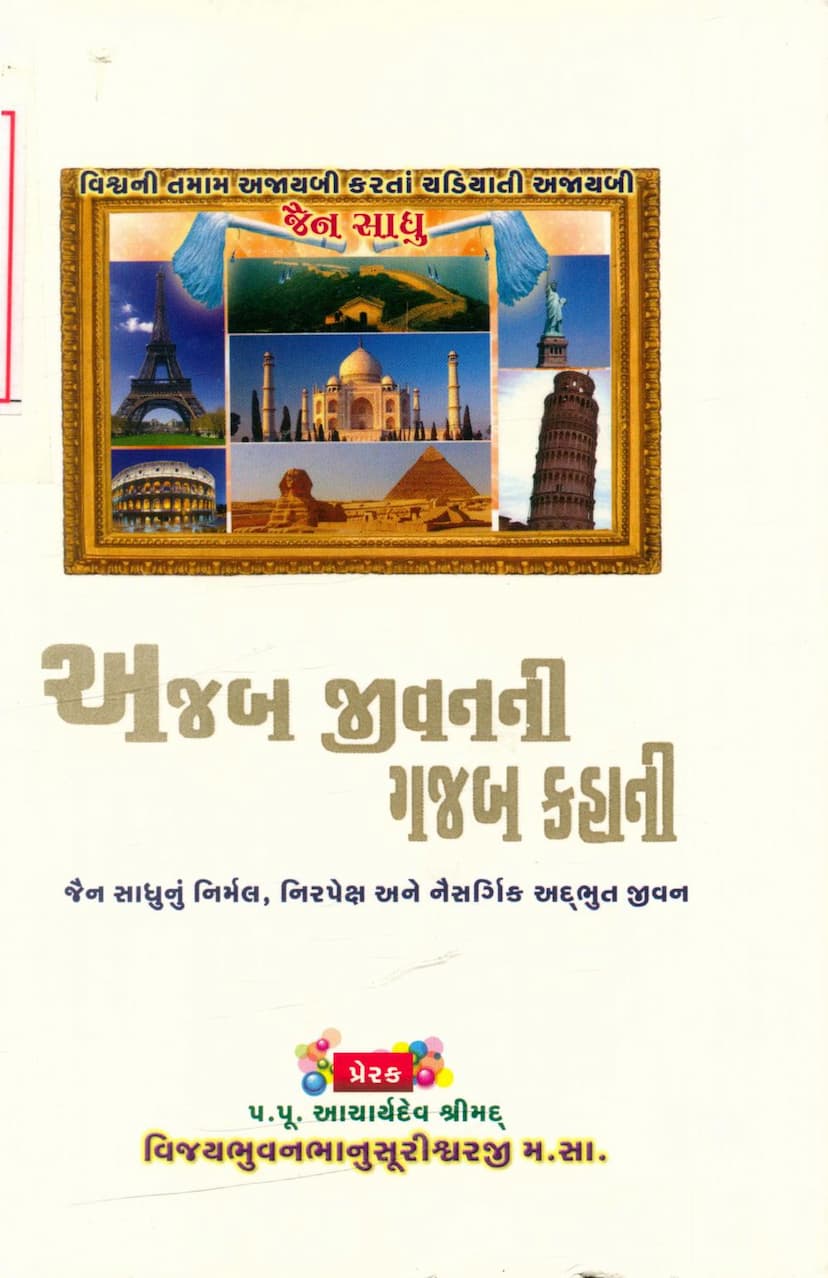Ajab Jivanni Gajab Kahani
Added to library: September 1, 2025

Summary
This Jain text, titled "Ajab Jivanni Gajab Kahani" (Amazing Life, Wonderful Story), authored by Gunhansvijay and Sanyambodhivijay, and published by Jainam Parivar, delves into the profound and often misunderstood life of a Jain monk. The book aims to illuminate the pure, detached, and natural existence of these ascetics, inspired by the teachings of Acharyadev Shrimad Vijaybhuvanbhanusurishwarji Maharaj.
The text begins by establishing that the life of a Jain monk is a wonder that surpasses all worldly marvels. It emphasizes the pristine, impartial, and natural beauty of their existence. The book is dedicated to Acharyadev Shrimad Vijaybhuvanbhanusurishwarji Maharaj, highlighting his role as a beacon of pure conduct and a well-wisher of the entire Jain community.
Key Themes and Content:
- The Essence of Jain Sadhana: The core of the book revolves around explaining the rigorous and disciplined life of Jain monks, their adherence to vows, and their ultimate goal of Moksha (liberation).
- The Analogy of a Doctor: The text frequently uses the analogy of a doctor to explain the Jain path. Arihant Bhagwan is presented as the supreme doctor, and the true Gurus (Sadhus and Sadhvis) as their disciples who administer the "medicine" of Jain principles. The worldly beings are depicted as patients suffering from various "diseases" of attachment, aversion, anger, ego, etc. The prescribed "medicine" is the practice of Jain dharma, leading to the eradication of these "diseases" and achieving spiritual health (Moksha).
- The Importance of Bhav (Inner State): A significant portion of the text emphasizes that the true essence of Jain dharma lies not just in external actions (activities) but in the inner state (Bhav). It clarifies that while external actions are important, the purity of intention and the absence of negative emotions (like attachment and aversion) are paramount. The text illustrates this with examples, showing how the same action can lead to different karmic consequences based on the underlying Bhav.
- The Concept of Moksha: Moksha is presented as the ultimate goal of all Jain practices, representing the state of complete freedom from suffering and the attainment of eternal bliss and pure consciousness.
- The Path to Moksha: The book meticulously explains that the entire Jain Shasan (tradition) is geared towards achieving Moksha. This includes the meticulous adherence to various rules, disciplines, and practices outlined by the Tirthankaras.
- Detailed Explanation of Jain Practices: The text goes into detail about the various aspects of a monk's life, including:
- The Five Mahavratas (Great Vows): Ahimsa (non-violence), Satya (truthfulness), Asteya (non-stealing), Brahmacharya (celibacy), and Aparigraha (non-possession). It breaks down each Mahavrata with its various nuances and implications.
- Twenty-Five Bhavanas (Meditations/Reflections): These are explained as practices that support the Mahavratas, fostering the right mental state for their observance.
- The Eight Prvachan Mata (Mothers of the Jain Precepts): These are further elaborated: five Samitis (right conduct in walking, speaking, eating, handling objects, and excretion) and three Guptis (restraint of mind, speech, and body). The text highlights their collective role in nurturing and purifying the monk's conduct.
- Tenfold Shraman Dharma: These are virtues like forgiveness, humility, simplicity, purity, etc., essential for a monk's spiritual progress.
- Various Kalpas (Rules of Conduct): The book details different levels of asceticism like Jinkalp (following the conduct of Tirthankaras), Pariharavishuddhi Kalpa, Yathasangdik Kalpa, and Pratimakappa, explaining their specific regulations and purposes.
- Daily Routine and Conduct: It outlines the meticulous daily schedule and the specific rules (Achar, Vichar, Vyavahar) that govern a monk's life, from waking up and performing rituals to observing strict food and behavioral disciplines.
- The Concept of Upadhis (Possessions): The text emphasizes the minimal possessions of a monk, detailing the specific types of necessary items like a muhapatti (mouth cloth), a broom (rajoharan), a water strainer (ojhari), and bowls, all of which are to be used with utmost care to avoid any harm to living beings.
- Pancha Achara (Five Conducts): These are Jnana Achara (conduct related to knowledge), Darshana Achara (conduct related to faith), Charitra Achara (conduct related to behavior), Tapa Achara (conduct related to austerities), and Virya Achara (conduct related to energy/effort). Each of these is further broken down into specific practices.
- The Significance of the Guru: The absolute reliance on the Guru's guidance is repeatedly stressed. The Guru is seen as the one who can interpret scriptures, guide through difficult situations, and ensure the correct application of principles.
- The Importance of Bhav (Inner State) over Bahya Kriya (External Action): While highlighting the strict external disciplines, the book repeatedly stresses that the ultimate measure of spiritual progress is the inner state of the monk – the purity of intention, the absence of attachment, aversion, and ego.
- The Concept of "Ekant" and "Anekant": The text discusses the Jain principle of Anekantavada (non-absolutism) and warns against falling into "Ekantavada" (absolutism), particularly in interpreting monastic rules. It explains that while certain practices are prescribed, flexibility based on specific circumstances and the guidance of a qualified Guru is essential.
- The Purity of Conduct (Sheel Raksha): A significant focus is placed on the strict adherence to Brahmacharya (celibacy) and the various "fences" (Vado) put in place to protect it. It also highlights the additional vigilance required by Sadhvis (nuns) to maintain their chastity.
- The Purpose of Jain Shasan: The book reiterates that the entire framework of Jainism, from the minute rules of conduct to the highest philosophical concepts, is ultimately aimed at achieving Moksha.
In essence, "Ajab Jivanni Gajab Kahani" is a detailed and insightful exploration of the ascetic path within Jainism. It seeks to demystify the life of a Jain monk, revealing it not as one of deprivation, but as a life dedicated to the highest spiritual pursuits, characterized by profound detachment, unwavering discipline, and a deep commitment to non-violence and self-realization. The book encourages readers to contemplate these principles and understand the true wonder and dedication involved in this unique way of life.